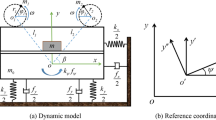Abstract
To analyze the vibration response of a rotor system with circumferential short spring dual mass flywheel (DMF) when the primary flywheel speed changes, the interactions (forces and torques) between the primary flywheel, spring seat, spring, and secondary flywheel are analyzed in detail, and the dynamic analysis model of the DMF rotor system is established considering the influence of clearance and friction between parts in the DMF in this study. The vibration response of the DMF is investigated by numerical method. By analyzing the bifurcation diagram, time history, phase trajectories, Poincaré section, and frequency domain of the relative angular displacement, the variation of vibration form of the system under different excitation frequencies are discussed. Besides, the effects of load, primary flywheel speed amplitude, and spring stiffness on system vibration are also analyzed. Finally, some of the results from the analytical study are verified through the DMF rotor system experiments.
Similar content being viewed by others
References
D. Szpica, Modelling of the operation of a dual mass flywheel (DMF) for different engine-related distortions, Mathematical and Computer Modelling of Dynamical Systems, 24(6) (2018) 643–660.
Z. Chen, Z. Chen, Y. Mao and W. Shi, Control research of power train torsional vibration based on magneto-rheological fluid dual mass flywheel, SAE Technical Paper (2014) 2014-1-2867.
L. P. He, C. G. Xia, S. D. Chen, J. W. Guo and Y. Liu, Parametric investigation of dual-mass flywheel based on driveline start-up torsional vibration control, Shock and Vibration (2019) Article ID 3171698.
A. Walter, S. Brummund, B. Merz, U. Kiencke, S. Jones and T. Winkler, Estimation of the instantaneous engine torque for vehicles with dual mss flywheel (DMF), IFAC Proceedings Volumes, 40(10) (2007) 167–174.
T. S. Kang, S. K. Kauh and K. P. Ha, Development of the displacement measuring system for a dual mass flywheel in a vehicle, Proceedings of the Institution of Mechanical Engineers, Part D: Journal of Automobile Engineering, 223 (2009) 1273–1281.
X. L. Tang, X. S. Hu, W. Yang and H. S. Yu, Novel torsional vibration modeling and assessment of a power-split hybrid electric vehicle equipped with a dual-mass flywheel, IEEE Transactions on Vehicular Technology, 67(3) (2018) 1990–2000.
L. Q. Song, L. P. Zeng, S. P. Zhang, J. D. Zhou and H. E. Niu, Design and analysis of a dual mass flywheel with continuously variable stiffness based on compensation principle, Mechanism and Machine Theory, 79 (2014) 124–140.
E. Güllü, A. Yılmaz and S. Gökdağ, Influence of single and dual mass flywheel usage in IC engines on the resonance behavior of the power transmission system, International Journal of Automotive Science and Technology, 3(4) (2019) 102–108.
E. Güllü and A. Ylmaz, Influence of single and dual mass flywheel usage in IC engines on clutch dynamics, International Journal of Automotive Science And Technology, 4(2) (2020) 40–48.
V. Berbyuk, Design optimization of torsional vibration absorbers for heavy-duty truck drivetrain systems, Vibration, 2 (2019) 240–264.
S. Theodossiades, M. Gnanakumarr, H. Rahnejat and P. Kelly, Effect of a dual-mass flywheel on the impact-induced noise in vehicular powertrain systems, Proceedings of the Institution of Mechanical Engineers, Part D: Journal of Automobile Engineering, 220 (2006) 747–761.
L. Chen, W. K. Shi and Z. Y. Chen, Modeling and experimental study on dynamic characteristics of dual-mass flywheel torsional damper, Shock and Vibration (2019) Article ID 5808279.
Y. L. Wang, X. P. Qin, S. Huang and S. Deng, Design and analysis of a multi-stage torsional stiffness dual mass flywheel based on vibration control, Applied Acoustics, 104 (2016) 172–181.
W. K. Shi, Y. Long and Y. D. Lu, Study on multistage non-linear dual mass flywheel damper, Journal of Vibration and Shock, 28(5) (2009) 92–96.
L. Q. Song, X. F. Zhao, Z. H. He, S. M. Luo, H. Y. Tian and Z. Z. Fan, Analysis model and inherent characteristics of torsional vibration of the dual mass flywheel-circumferential short spring introduced friction, Journal of Mechanical Engineering, 45(11) (2009) 99–105.
D. M. Chen, Y. Y. Ma, W. Sun, X. L. Guo and X. F. Shi, Research of design and vibration reduction of dual mass flywheel with arc helix spring, Proceedings of 2011 International Conference on Electronic & Mechanical Engineering and Information Technology, Harbin, Heilongjiang, China (2011) 2706–2709.
G. H. Li, J. J. Hu and D. T. Qin, Study on natural torsional vibration characteristics of dual mass flywheel-radial spring type torsional vibration damper, China Mechanical Engineering, 19(15) (2008) 1800–1805.
Y. Mao, Z. Y. Chen, W. K. Shi, G. M. Wu, S. C. Wang and N. Sun, Torsional vibration damping characteristics of magnetorheological fluid dual mass flywheel, Journal of Xi’an Jiaotong University, 48(6) (2014) 127–133.
Q. H. Zu, Z. Y. Chen, W. K. Shi, Y. Mao and Z. Y. Chen, Torsional vibration semiactive control of drivetrain based on magnetorheological fluid dual mass flywheel, Mathematical Problems in Engineering (2015) Article ID 608737.
S. Lee, S. K. Jayachandran, Y. Jang and D. Lee, Torsional filtration improvement with centrifugal pendulum DMF in rear wheel drive system, International Journal of Automotive Technology, 20(5) (2019) 917–922.
Z. H. Lü, Z. G. Wu and T. Chen, The design principles and performance analysis of DMF-CSS torsional damper, Automotive Engineering, 25(5) (2003) 493–497.
Acknowledgments
This work is supported by the National Natural Science Foundation of China (Grant No. 51805167), the Natural Science Foundation of Jiangxi Province (Grant No. 20171BAB 216029), and the Foundation of Educational Department of Jiangxi Province (Grant No. GJJ170403).
Author information
Authors and Affiliations
Corresponding author
Additional information
Liping Zeng is currently a Lecturer of the School of Mechatronics and Vehicle Engineering, East China Jiaotong University, China. He received his Ph.D. in Mechanical design and theory from Chongqing University. His research interests include mechanical system dynamics and nonlinear vibration.
Rights and permissions
About this article
Cite this article
Zeng, L., Liu, J., Wan, Z. et al. Modeling and vibration characteristics analysis of a DMF rotor system. J Mech Sci Technol 36, 2799–2810 (2022). https://doi.org/10.1007/s12206-022-0512-0
Received:
Revised:
Accepted:
Published:
Issue Date:
DOI: https://doi.org/10.1007/s12206-022-0512-0




